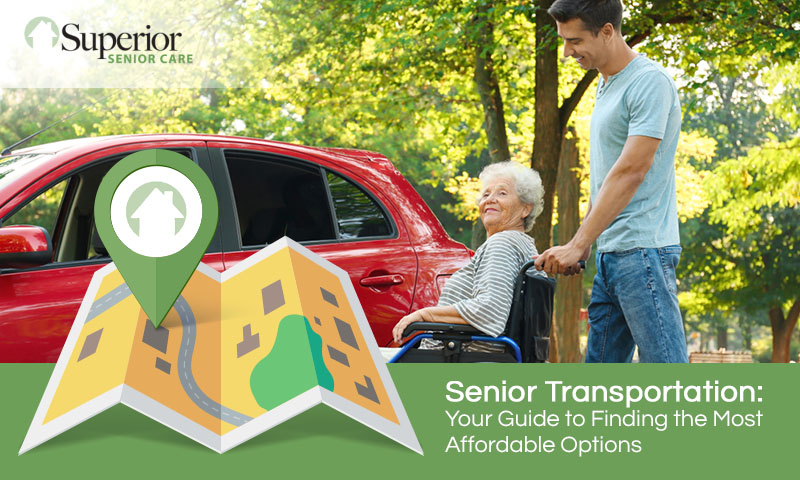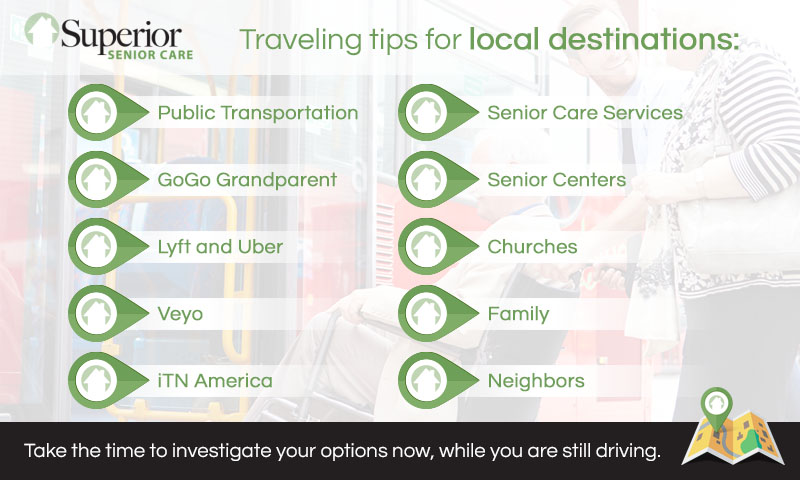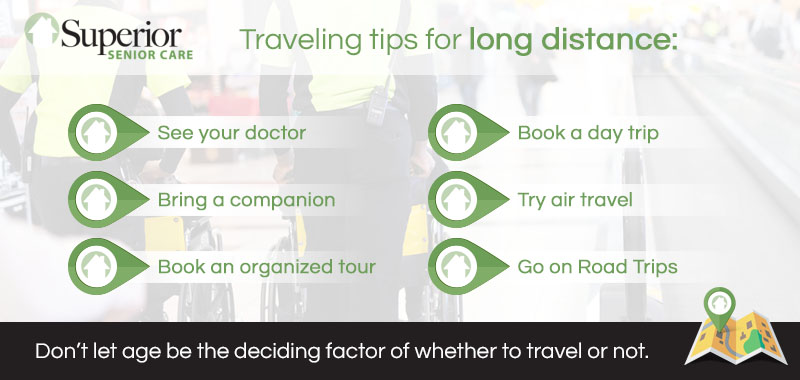 One of the most difficult decisions most seniors have to make is when to give up driving. When you were young and you passed your driving test, a door opened to a whole new life. Now, when you are a senior, it feels like that same door is slamming shut.
One of the most difficult decisions most seniors have to make is when to give up driving. When you were young and you passed your driving test, a door opened to a whole new life. Now, when you are a senior, it feels like that same door is slamming shut.
There are certain changes that cause a senior to start thinking about giving up driving. Maybe they notice that their reflexes aren’t as quick as they once were. Many elderly find it more difficult to see at night, and they only drive during the day. Some become uncomfortable driving in unfamiliar places. So, gradually, the distance from home becomes smaller and smaller, and driving is limited to essential trips. You know with each adjustment that you are moving closer to not driving at all.
At the same time that you are going through these steps, so are your friends, your peer group. They may be further along this journey or slightly behind you, but the end will be the same. At some point, you will have to stop driving. With that decision comes the potential loss of independence.
How will you get your groceries, get to appointments, or even see your friends? Your adult children may live near you, but they are still working. You don’t want to burden them with driving you places, anyway.
There are a number of alternative means of transportation. The availability of them will, in part, be determined by where you live. Also, cost is a consideration. Take the time to investigate your options now, while you are still driving. Try each and see how it works for you. Then, when you are ready to make the decision to stop driving, you will have an alternative plan that you can feel confident will work for you. Try these traveling tips for local destinations:

1. Public Transportation. Generally, this is the city bus. While there will not be any assistance getting on and off the bus, there are handicapped-accessible buses that include wheelchair lifts. If you are able to get to the bus stop and get on and off the bus independently, this may be an acceptable alternative for you. There is a bus service that is available free or at low cost for those who need door-to-door service. Usually provided through the county, it is available throughout most of the U.S. Call your area’s Agency on Aging, and they will connect you with available service.
2. GoGo Grandparent. This is a concierge service that connects the senior with a service like Uber or Lyft. They will have a driver at your door within minutes. The drivers are screened, and the ride is monitored. In addition, a family member will be notified about the trip via text if you want. Walkers and foldable wheelchairs are acceptable; however, the senior will have to be able to get in and out of the car unassisted. The cost will be the usual fee for the on-demand ride, plus an additional fee for the concierge service. This is still lower than a taxi.
3. Lyft and Uber. Lyft and Uber are the largest on-demand ride services. They can have transportation at your door in minutes. You will have to be able to get in and out of the vehicle without assistance and have the ability to use the app, as well as pay automatically with a credit card. Some assisted living facilities and medical clinics are contracting with Lyft or Uber to provide concierge service without any charge to the senior. Ask your local agency if they have a partnership with Lyft or Uber.
4. Veyo. This is a company that partners with insurance companies to provide non-emergency transportation to a medical facility. This is for people who are confined to a wheelchair or stretcher. This must be included as a benefit of your insurance. There is no cost for the senior if Veyo is a listed benefit of the senior’s insurance. The appointments can only be scheduled by the healthcare facility with the service. The senior can’t schedule transportation themselves.
5. iTN America. This is a national network of senior ride companies. The difference between them and Lyft or Uber is that they transport door through door. This difference means that, rather than just drop you at the curb of the address you gave, you will be escorted into the door of your destination. Assistance in and out of the vehicle will be provided also. This service is available in limited areas. If it is available in your location, it is a great option.

6. Senior Care Services. The senior care service you choose can either run errands for you or they can transport you to your destination. So, if you need some groceries, the caregiver will take you to the grocery store and accompany you while you shop, and then return to your home. The caregiver can also help with bringing the groceries into the house and putting them away.
Home care services like Superior Senior Care of Arkansas can schedule a caregiver for a regular time weekly for things like grocery shopping or Sunday church service. They also can transport on an appointment basis when you have a doctor or dentist appointment.
7. Senior Centers. Some senior centers have bus transportation available for limited hours each day. There is no charge, but this is not usually an option for appointments where punctuality is important. The route taken may depend on where other riders are going. The same is true when you are ready to return home. You may have to wait a while for the bus to return.
8. Churches. Many churches have volunteer programs established to assist the elderly. The members will assist with transportation and companionship. Some will provide assistance and transportation to religious celebrations and services. There is no charge, but it is dependent on availability of the volunteers.

9. Family. We all think of our children when we need help. But what if they are unable to help because of their work travel? Some families are separated by long distances, making it impossible for them to help. What about grandchildren who are of driving age? Cousins, nieces, and nephews might be willing to help out. You could offer to pay them or give them a gift card for gasoline in thanks.
10. Neighbors. Ask your neighbor if you could go with her when she does her grocery shopping. It won’t be out of her way. This can work as long as you are willing to be flexible about when you will shop.
Remember, you don’t have to rely on just one of these means of transportation. You can use them all. You choose which will work best, depending on your destination and the time of day.
Those traveling tips are great for local destinations, but what if you want or need to travel long distances? Traveling a long distance or even abroad is more difficult for most seniors, but especially if you are an inexperienced traveler. Don’t let age be the deciding factor of whether to travel or not. Here are some tips for long distance travel.

11. See your doctor. Tell your doctor about your planned trip. Talk to the doctor about any health issues that need to be addressed before the trip. Also, discuss any possible impact of long-distance travel on any existing health issues. Once your doctor says it is okay to proceed with your plans, you can move forward.
12. Consider going with a traveling companion. It is always less stressful to travel with someone, rather than alone. Consider going with a friend or relative with whom you are compatible and who has similar interests to you. If you are going to New York to see Broadway shows, don’t choose a companion who isn’t interested in theater.
13. Book an organized tour. The advantage of a tour is that everything is included. Your travel at the destination, the hotels, and most meals are all planned and included in the cost of the tour. The itinerary and entrance fees to attractions are also included. Basically, once you reach the departure spot, the mechanics of the trip are the tour company’s responsibility. Booking a tour removes a lot of the stress of traveling.
14. Book a day trip. Senior centers, church groups, and other organizations offer day trips to attend sporting events, theater productions, festivals, and other events throughout the state. You board a charter bus and sit back and relax until you reach your destination. Usually the cost is reasonable, and it gives you an opportunity to enjoy events outside of your own community.

15. Try air travel. If you will be flying to your destination, talk to the airlines about senior services. If they know ahead of time, they will have you met by airline assistance with a wheelchair to take you to your gate. Even if you don’t normally use a wheelchair, this might be the time!
Some airports are huge, and trying to walk that long distance to your gate may leave you exhausted. The wheelchair assistance can also be arranged for you if you need to change planes at a layover. The airlines can also give you priority boarding, which means you get on the plane first and can be settled in your seat before everyone else boards. It truly is worth taking advantage of the senior perks.
16. Go on Road Trips. If you have decided to take a long-distance trip by car, there are several advantages. The travel is more flexible. You can stop as often as you want for as long as you want to. You should stop every two hours for a bathroom break and to exercise your legs. Just walking is sufficient, but it is important to work your leg muscles to get the circulation moving after sitting in the car for an extended time. Drink an adequate amount of fluids to prevent dehydration. Bring along some healthy snacks so you aren’t tempted by the fast-food stops.
With some thoughtful planning, all seniors will be able to compensate for their inability to continue driving. In addition to daily living requirements, there are many opportunities to travel, even if you don’t drive any longer.

